Ma Ke takes classic apparel-making to Tangjiawan hall
Internationally acclaimed fashion designer Ma Ke and her local team of spinners, weavers, dyers, and sewers have created the fully functional Hand Spinning-Weaving Inheritance & Practice Hall in the Tangjia Village History Center.
The new hall and center are in the Tang Ruizhi (Yuwo) Family Shrine on Shanfang Road next to the former residence of Tong Shao-yi (Tang Shaoyi, the first premier of the Republic of China).
Ma and her Wu Yong (Useless) artistic brand crew took charge of planning and construction with funding of 3.7 million yuan ($575,100) from the National Hi-Tech Industrial Development Zone (Tangjiawan).
Ma's haute couture line have been completely done in a workshop in Zhuhai, according to a 2015 story on agnautacouture.com. It states that all stages of production are done in-house, even using traditional equipment such as a Chinese loom dating from the 19th century.

Hand Spinning-Weaving Inheritance & Practice Hall [Photo by Liu Jiacheng / Guanhai App]
Her repurposed section in the history center has zones for the exhibition of raw materials, hand spinning, weaving skills, tailoring and sewing, plant dyeing, and historical attire. To the left of the hall is a brief introduction to China's natural textile fibers and hand-weaving history. Many kinds of looms, staining jars and dyed fabrics in the middle of the hall display the beauty of spinning and weaving techniques and procedures.
Textile raw materials including cotton, flax, silk, wool, and camel and yak hair are exhibited in the Raw Materials Zone. Illustrations depict how much cotton is required to make a piece of clothing by hand.
The patio of the ancestral hall displays traditional Tangjia clothing, varying in style between the attire of officials and common people – some fancy and other casual – that date back more than 100 years.
An impressive number of plants can be used to dye clothes. Displays include the madder, lithospermum, safflower, logwood, nutgall, turmeric, wormwood, indigo, onion, and black tea. In addition, there are characteristic Zhuhai dyes such as lychee, banyan tree, delonix regia, and bidens pilosa.
In today's fast-paced life, people change clothes frequently, which Ma said is a waste. The exquisiteness of the handmade clothes cannot be compared to what is produced by emotionless production lines.
In light of the decline of traditional handicraft skills, the most effective protection is not only to apply for cultural heritage status and build museums, but also to focus on learning, inheritance, and innovation, explained Ma, who seeks to advance both protections in her clothing facility.
The hall is open 10 am-7 pm, admission-free, Tuesdays to Sundays, and will remain operational during the Spring Festival holiday, except Thursday, Feb 11, Lunar New Year's Eve.
To get there, drive to "共乐园一号停车场" (Gongleyuan Park Parking Lot 1) using GPS navigation, then walk about 600 m (656 yd) southeastward along Shanfang Road. Or take Bus 3, 3A, 10, 10A, 66, 68, 69, 85, K1, K2, or K3 to "唐家" (Tangjia) and walk 1 km (1,094 yd) to the destination.



